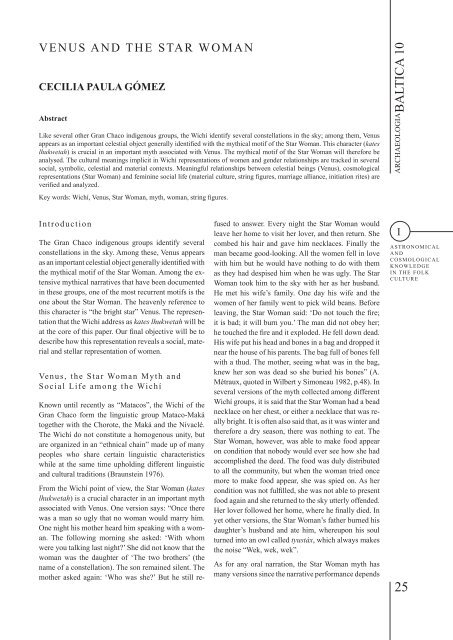BALTICA10
BALTICA10
BALTICA10
You also want an ePaper? Increase the reach of your titles
YUMPU automatically turns print PDFs into web optimized ePapers that Google loves.
VENUS AND THE STAR WOMAN<br />
CECILIA PAULA GÓMEZ<br />
Abstract<br />
Like several other Gran Chaco indigenous groups, the Wichí identify several constellations in the sky; among them, Venus<br />
appears as an important celestial object generally identified with the mythical motif of the Star Woman. This character (kates<br />
lhukwetah) is crucial in an important myth associated with Venus. The mythical motif of the Star Woman will therefore be<br />
analysed. The cultural meanings implicit in Wichí representations of women and gender relationships are tracked in several<br />
social, symbolic, celestial and material contexts. Meaningful relationships between celestial beings (Venus), cosmological<br />
representations (Star Woman) and feminine social life (material culture, string figures, marriage alliance, initiation rites) are<br />
verified and analyzed.<br />
Key words: Wichí, Venus, Star Woman, myth, woman, string figures.<br />
ARCHAEOLOGIA BALTICA 10<br />
Introduction<br />
The Gran Chaco indigenous groups identify several<br />
constellations in the sky. Among these, Venus appears<br />
as an important celestial object generally identified with<br />
the mythical motif of the Star Woman. Among the extensive<br />
mythical narratives that have been documented<br />
in these groups, one of the most recurrent motifs is the<br />
one about the Star Woman. The heavenly reference to<br />
this character is “the bright star” Venus. The representation<br />
that the Wichí address as kates lhukwetah will be<br />
at the core of this paper. Our final objective will be to<br />
describe how this representation reveals a social, material<br />
and stellar representation of women.<br />
Venus, the Star Woman Myth and<br />
Social Life among the Wichí<br />
Known until recently as “Matacos”,tthe Wichí of the<br />
Gran Chaco form the linguistic group Mataco-Maká<br />
together with the Chorote, the Maká and the Nivaclé.<br />
The Wichí do not constitute a homogenous unity, but<br />
are organized in an “ethnical chain” made up of many<br />
peoples who share certain linguistic characteristics<br />
while at the same time upholding different linguistic<br />
and cultural traditions (Braunstein 1976).<br />
From the Wichí point of view, the Star Woman (kates<br />
lhukwetah) is a crucial character in an important myth<br />
associated with Venus. One version says: “Once there<br />
was a man so ugly that no woman would marry him.<br />
One night his mother heard him speaking with a woman.<br />
The following morning she asked: ‘With whom<br />
were you talking last night?’ She did not know that the<br />
woman was the daughter of ‘The two brothers’ (the<br />
name of a constellation). The son remained silent. The<br />
mother asked again: ‘Who was she?’ But he still refused<br />
to answer. Every night the Star Woman would<br />
leave her home to visit her lover, and then return. She<br />
combed his hair and gave him necklaces. Finally the<br />
man became good-looking. All the women fell in love<br />
with him but he would have nothing to do with them<br />
as they had despised him when he was ugly. The Star<br />
Woman took him to the sky with her as her husband.<br />
He met his wife’s family. One day his wife and the<br />
women of her family went to pick wild beans. Before<br />
leaving, the Star Woman said: ‘Do not touch the fire;<br />
it is bad; it will burn you.’ The man did not obey her;<br />
he touched the fire and it exploded. He fell down dead.<br />
His wife put his head and bones in a bag and dropped it<br />
near the house of his parents. The bag full of bones fell<br />
with a thud. The mother, seeing what was in the bag,<br />
knew her son was dead so she buried his bones” (A.<br />
Métraux, quoted in Wilbert y Simoneau 1982, p.48). In<br />
several versions of the myth collected among different<br />
Wichí groups, it is said that the Star Woman had a bead<br />
necklace on her chest, or either a necklace that was really<br />
bright. It is often also said that, as it was winter and<br />
therefore a dry season, there was nothing to eat. The<br />
Star Woman, however, was able to make food appear<br />
on condition that nobody would ever see how she had<br />
accomplished the deed. The food was duly distributed<br />
to all the community, but when the woman tried once<br />
more to make food appear, she was spied on. As her<br />
condition was not fulfilled, she was not able to present<br />
food again and she returned to the sky utterly offended.<br />
Her lover followed her home, where he finally died. In<br />
yet other versions, the Star Woman’s father burned his<br />
daughter’s husband and ate him, whereupon his soul<br />
turned into an owl called tyustáx, which always makes<br />
the noise “Wek, wek, wek”.<br />
As for any oral narration, the Star Woman myth has<br />
many versions since the narrative performance depends<br />
I<br />
ASTRONOMICAL<br />
AND<br />
COSMOLOGICAL<br />
KNOWLEDGE<br />
IN THE FOLK<br />
CULTURE<br />
25
















